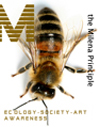
Trees: a conversation? > >
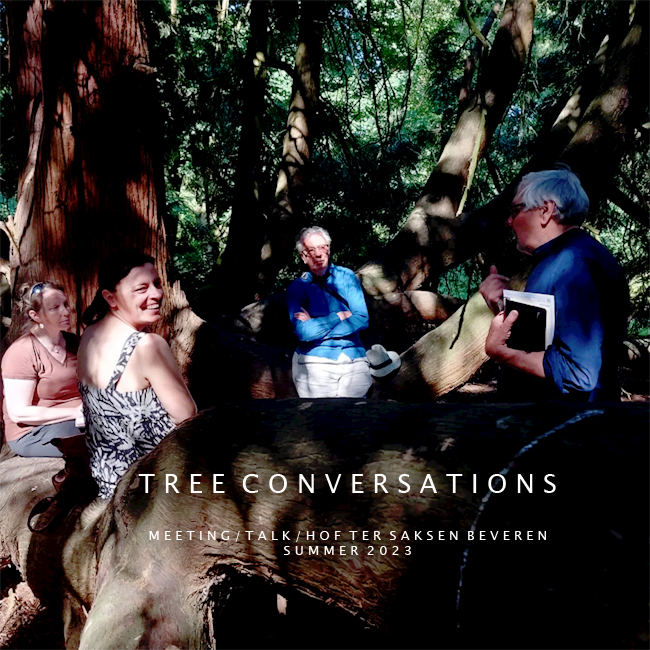
[ an ongoing process of talks, workshops, experiences, letters...]
![]()
A Tree History :
[ I . A M . A . T R E E ] Rasa vzw travelling school exhibition 'Ik ben een boom' 1997 > 1999.

Axis Mundi [1993]
During the walks, we embraced trees. We also stood on the stumps of cut-down trees as an ecological statement—a small natural "speaker’s stage" from which to hold speeches or read letters. We tried to imagine how the tree once looked when it was whole, aiming to become aware, to feel and embody the tree’s presence and energy.
Photo: Hof Ter Saksen, Beveren, Belgium, 1992 (Embracing Trees)
Stefaan van Biesen’s passion for the natural world—and trees in particular—became the foundation for the traveling educational exhibition I am a Tree. The project was presented in multiple schools and reached over twelve thousand visitors.
Van Biesen was co-founder and president of VZW RASA (Art Education for Youth), active from 1994 to 1999.
Can a tree be your friend? Can trees feel? Do we need trees? Myths and rituals reveal the vital role trees play in human life and the ongoing cycle of nature. This exhibition features works by ecologically committed artists from Denmark, including Wilfried Genard, Wladimir Moszowski, Kris Vanhemelryck, Sara Stoop, Jo Bracke, and Stefaan van Biesen.
Rasa Art Education feels nostalgic. #rasacreëert Retrospect: 'I am a tree/ Ik ben een boom'' expo 1997.
Watch the video:

B O O M . P R A T E R [ T R E E . T A L K E R ] [ 2 0 0 3 ] .
A whispering installation | support system to encourage a young tree and give it strength to grow tall.
In situ installation Beeldig Hof Ter Saksen [Uit Hetzelfde Hout Gesneden]. Project curator Stefaan van Biesen.
CC Ter Vesten Beveren Belgium. Les Ventinelles Anglet France 2005.
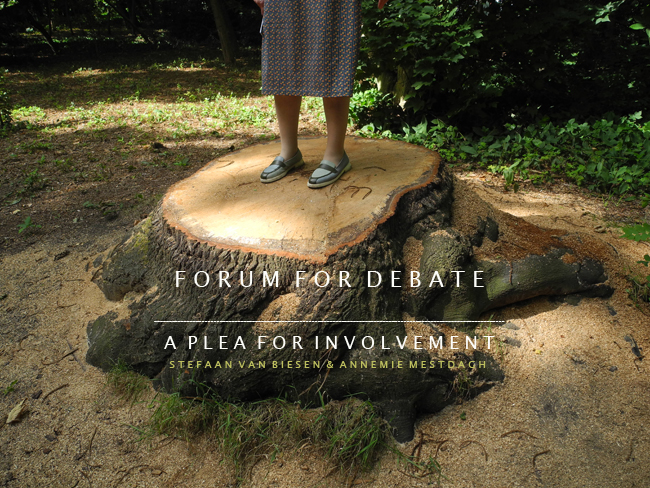
Actions and relations with trees :

Method I: Broadly Documented Walks
Research in the urban human environment through walks as sensory experiences—captured and documented to reveal both scientific and aesthetic dimensions.
In 2005, Ingrid Pee (former assistant to Joseph Beuys during the 7000 Oaks project at Documenta, Kassel, Germany) introduced us to the concept of Spaziergangwissenschaft (“the science of walking”). This idea was developed in the 1990s at the University of Kassel by Swiss sociologist and urbanologist Lucius Burckhardt (1925–2003). Walking was elevated as a means of observing and engaging with space.
This concept perfectly aligned with my own work and way of thinking. It was a revelation to discover that my practice fits within an artistic tradition—a large family of predecessors dedicated to similar explorations.
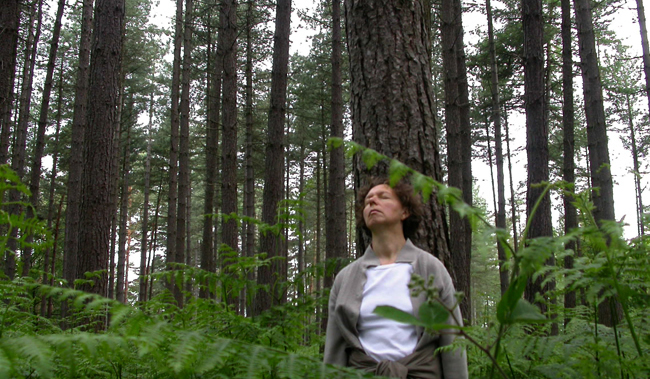
Method II: Between 2000 and 2004
I was a member of Bewust Wandelen (“Walking Consciously”), a small alternative group of artists, writers, and therapists exploring the concept of geomancy. Guided by the inspired leadership of Kris Tolomei, the group regularly organized lectures and walks at energetic sites across Belgium and the Netherlands.
Photo: Annemie Mestdagh during a sensorial walk in the Zoniënwoud near Brussels with a large group organized by Joel Libert.
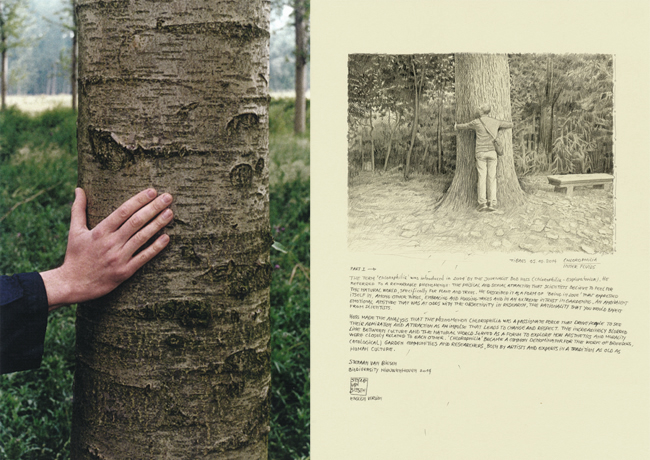
• [ L I K E . T H E . B L A C K . M U L B E R R Y . ( 4 ) ] | Z O A L S . D E . Z W A R T E . M O E R B E I ]
Hortus walk Hof Ter Saksen Beveren 11.05.2025.
In the early 2000s, Stefaan van Biesen initiated a series of walks where participants were invited to deliver speeches or engage in public conversations on the stumps of sawn-off trees. This group practice inspired several studies, letters, drawings, and artworks. From these experiences emerged the sculpture “Her-Steller | Restorer” (located at Dorpsplein near the Sint-Martinus Church, Massemen, Wetteren, 2006), commissioned by the Province of East Flanders as part of the project “A Home for a Statue | Een Thuis voor een Beeld.”
Unlike the classical Greek myth of Daphne, this work is rooted in an ecological and social public dialogue. The sawn-off tree trunk serves as a natural platform for speakers—nature itself providing a stage for reflection and meaningful discourse, a sanctuary for dialogue where views and experiences are shared.
On May 11, 2025, participants in the Hortus walk shared this natural Speaker’s Corner as part of “Like the Black Mulberry | Zoals de Zwarte Moerbei,” a project focusing on trees as memorials. In this case, the Mulberry Tree symbolizes the many asbestos-related deaths and victims in the Sint-Niklaas, Beveren, and Antwerp harbor regions.

Tree Talkers: Stefaan van Biesen, Etienne D'Hollander, Christa Maes, Serverius, Rika Van de Walle, Hilde Reyniers, ...
![]()
• [ L I K E . T H E . B L A C K . M U L B E R R Y . ( 2 ) ] • a social art project/installation by Anna Maria Mestdagh & Stefaan van Biesen about interviews with asbestos victims • Location: fort Liefkenshoek,Ketenislaan 4, 9130 Beveren Belgium. From 23.02 > 25.05.2025.

Guided Tree Walk and Conversation on Asbestos
Join Stefaan van Biesen and Annemie Mestdagh for a joint walk to the installation on the dike of Fort Liefkenshoek. Along the way, we listen to excerpts from interviews with asbestos victims and their relatives, as well as Herinneringen aan een militair bastion by Hilde Reyniers.
Our meeting point is the officers' quarters, where Johan De Vos, founder of Stoff vzw, shares the story of asbestos—from its origins to its arrival at the port of Antwerp. Following the walk and listening session, we engage in an open conversation about the legacy and impact of asbestos.
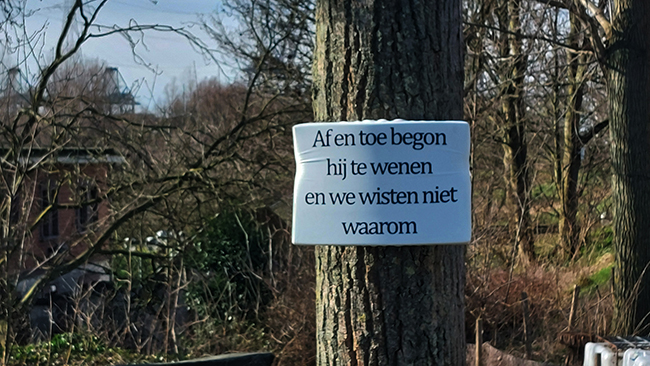
Like the Black Mulberry is a collaborative initiative with Stoff vzw, Stefaan van Biesen & Annemie Mestdagh, Meulenberg BinnensteBuiten, the Bib, Hortus ter Saksen, and the Department of Culture and Nature Development.
Through four guided tree walks, this project invites participants to engage in meaningful dialogue about memory, nature, and community.

The project began in November 2023 with a new “Letter to a Tree” — an artistic and socio-ecological initiative that quickly grew into a wider movement. We are continuing to develop this connective project in collaboration with a diverse group of local partners, including artists, experts, doctors, writers, and community stakeholders.

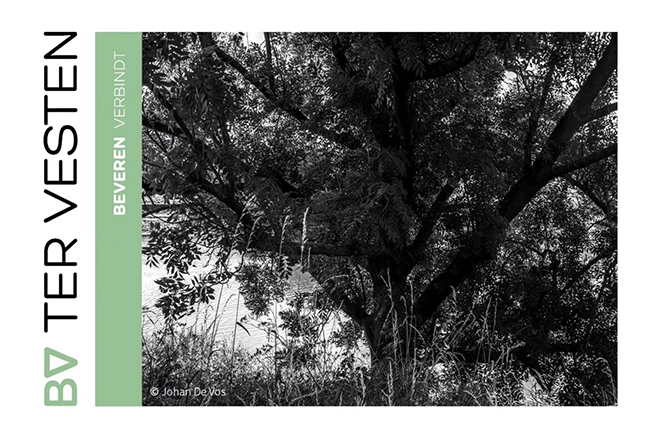
This participatory project aims to identify and preserve special commemorative trees at risk of disappearing. The Black Mulberry has become a significant symbol, linked to the many asbestos victims in the city of Sint-Niklaas. However, asbestos continues to claim lives daily in the region stretching from the Port of Antwerp to the inland areas.
This ongoing tragedy is the result of decades of cover-ups driven by inhumane profit motives, despite the well-known deadly effects of asbestos exposure—such as lung cancer—on thousands of factory workers in the local asbestos industry. It was not ignorance but a crime committed in the name of economic gain and private wealth.
Thanks to the efforts of numerous advocates, this Black Mulberry tree is now protected as a designated natural monument. On September 22, 2024, it was officially recognized as a memorial tree honoring the victims of asbestos.
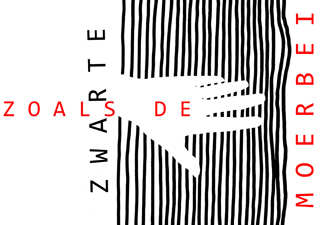 logo ©Anna-Maria Mestdagh & Stefaan van Biesen 2024
logo ©Anna-Maria Mestdagh & Stefaan van Biesen 2024
Johan De Vos (writer): "It was wonderful to experience that moment. The mulberry in the Brouwershof park on Hazewindstraat automatically takes on the allure of a memorial tree, because it is what it is. Rather old, a little crooked, with ailments like those of aged men, but still full of life. It is surrounded by social housing, the Turkish mosque and the still standing tower of the "standing seesaw" in Pastoor De Meerleerstraat. We then know that Christiane Thijs (1943-1988 asbestos victim) still knew that tree. It is the tree of the hope, life and beauty. Thanks to Stefaan Van Biesen, who reads one of his 'letters to trees' standing by that tree".

This participatory project aims to identify and protect special commemorative trees at risk of disappearing. The Black Mulberry has become a poignant symbol linked to the many asbestos victims in the city of Sint-Niklaas. Yet asbestos continues to claim lives daily in the region between the Port of Antwerp and inland areas.
This tragedy stems from years of cover-ups driven by inhumane monetary gain, despite the well-known deadly effects—such as lung cancer—on thousands of factory workers in the local asbestos industry. This was no ignorance; it was a crime committed in the name of profit and private wealth.
Thanks to the dedication of many advocates, this Black Mulberry tree is now a protected natural monument. On September 22, 2024, it will be officially recognized as a memorial tree for asbestos victims. And we are doing this together.

A portabel museum box [10 cm x 10 cm x 10 cm].
It began in November 2023 with a new "letter to a tree," an artistic and socio-ecological gesture that spontaneously grew into a larger movement.
We are developing this connecting project in collaboration with a diverse group of local partners—artists, experts, doctors, writers, and community stakeholders. After several group meetings, we designed a broad, educational, and promising school program, including partnerships with libraries, building on previous ideas developed by the Milena Principle.
A tree as a memorial monument
This participatory project aims to identify and preserve special commemorative trees before they disappear. So far, the Black Mulberry has become a powerful symbol associated with the many asbestos victims in the city of Sint-Niklaas. Yet asbestos continues to claim lives daily in the region between the Port of Antwerp and inland areas.
This ongoing tragedy is the result of years of cover-up driven by inhumane monetary gain, despite the well-documented deadly effects of asbestos—such as lung cancer—on thousands of factory workers in the local asbestos industry. This was no accident or ignorance; it was a crime committed in the name of profit and private wealth.
Thanks to the dedication of many advocates, this Black Mulberry tree is now a protected natural monument. On September 22, 2024, it will be officially recognized as a memorial tree for the victims of asbestos. And we are doing this together.

Drawing [ink on paper] Stefaan van Biesen: first tree conversation 2023
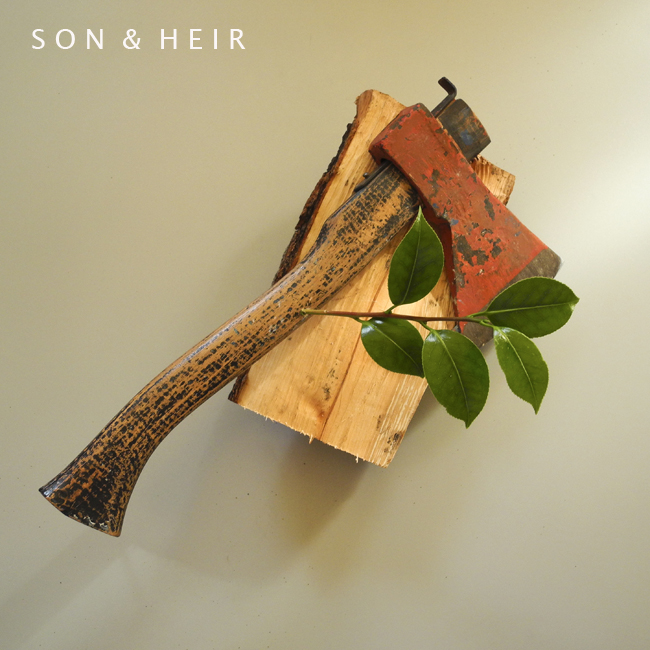
[ S O N & H E I R ] 2 0 1 9 .
M O N O L I T H
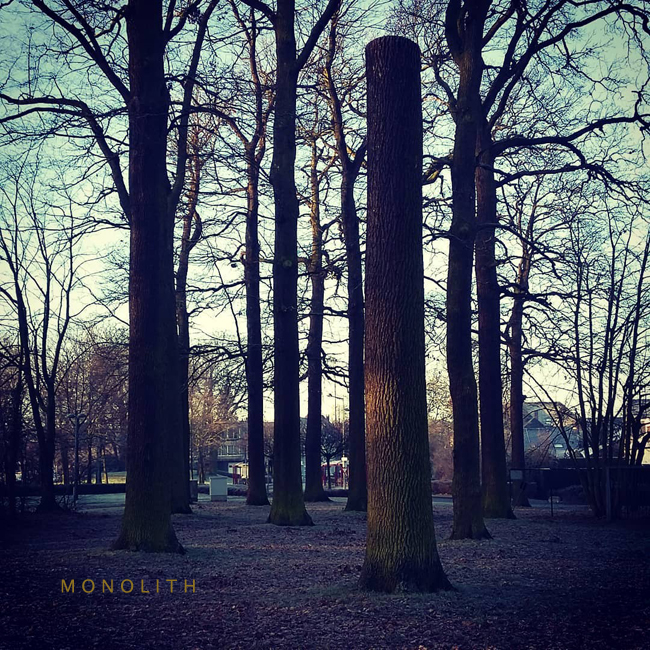

H E R - S T E L L E R / R E P L A C E R [ 2 0 0 6 ] .
Sculpture public space [Thuis voor een Beeld, Provincie Oost-Vlaanderen] Massemen Wetteren Belgium. Starting form performances with friends, the act of standing on the remains of trees, considered as a 'speakers corner', became a sculpture.

B U Z Z E R ( I ) [ 2 0 0 3 ] .
In situ installation Beeldig Hof Ter Saksen CC Ter Vesten Beveren Belgium.

B U Z Z E R ( II ) [ 2 0 0 3 - 2 0 2 3 ] .
In situ installation Exhibition Sporen in het landschap, Moerbeke Belgium 2021. Art Flow Zwolle [NL] 2022.

( F ) L U I S T E R H U I S J E [Little House of Whispers] [ 1 9 9 8 ] .
In situ installation [An Ear on the Grass] Park Ter Beuken Lokeren Belgium. Photo: Paul De Malsche

I N S C R I P T I O N X [ 1 9 9 3 ] .
In situ installation Park Blauwendael Waasmunster, Belgium.

B O O K / B E U K / B O O K / C A R R I E R [ P O R T A B L E V E R S I O N ] [ 1 9 9 3] .
In situ istallation at Hof Ter Saksen Beveren, Belgium.
A T R E E C O N V E R S A T I O N [ 2 0 1 9 ] .
Hof Ter Saksen Beveren Belgium. Sound Walk Sunday September 2019.

Sound Walk Sunday 2019 took place on Sunday, 1st September, in London, UK, as part of a global week-long festival celebrating sound walking events and performances. This worldwide event showcases outdoor audio, geo-located immersive performances, listening walks, and sound walks. In the months following, calls will be issued for walking pieces produced since Sound Walk Sunday 2017, as well as new works to premiere at Sound Walk Sunday 2019.
The Museum of Walks in London serves as a collaborative platform, inviting like-minded artists and walkers to present artistic sound projects simultaneously on this day. For this cross-border project, Stefaan van Biesen and Annemie Mestdagh are presenting a Wander Weed session in Beveren, Belgium. This performative walk blends lecture, conversation, and exercise, focusing on our relationship with plants and plant intelligence. The session builds on previous projects such as Plant(e)scape Made of Walking IV (Akamas, Cyprus 2018) and The Walking Body (Minho University, Guimarães, Portugal 2019).
C H L O R O P H I L I A [ 2 0 1 4 ].

Chlorophilia (from the Greek chloros meaning “pale green” and philia meaning “love”) was first introduced in 2004 by journalist Bob Hoss (Chlorophilia – Exploratorium). He described a remarkable phenomenon: the physical and emotional attraction that some scientists feel toward the natural world, especially plants and trees. This love manifests in behaviors such as tree-hugging and a profound passion for gardening—an ambivalent emotional stance that contrasts with the objectivity and rationality typically expected in scientific research.
Hoss analyzed chlorophilia as a passionate force driving people to channel their admiration and attraction into a catalyst for change and respect toward nature. The increasingly blurred boundaries between culture and the natural world provide a space to explore how aesthetics and morality intertwine. Chlorophilia has become a common thread connecting the work of breeders, ecological gardening communities, artists, and researchers—carrying on a tradition as old as human culture itself.
In recent decades, the dialogue between art and science has reemerged, fueled by social, societal, and environmental concerns. This dialogue creates an exciting meeting point between reason and intuition, body and spirit, culture and nature—a cherished utopia of opposites that, in my view, are not entirely irreconcilable.
Respect for the natural world and a sense of wonder as tools for creativity in daily life are essential ingredients for sustaining biodiversity in all its forms. We are invited to see ourselves less as mere consumers and more as global citizens. Ecology becomes synonymous with “caring”—a social commitment and a transnational attitude grounded in the compelling question of how to exist not in isolation but as part of the world. Life and art become silent, tender gestures that ripple outward, never unnoticed.
Every action carries meaning for someone, for the “other.” Deep down, we cannot escape the sprouting, boundless wisdom of biodiversity, where all beings and things are interconnected—reminding us that “even the flight of a butterfly affects the entire planet.”
Stefaan van Biesen 2014.
A tree library
A P P E N D I X ( I ) [ 2 0 0 3 ] .
[Tree Library] Beeldig Hof Ter Saksen Beveren 2003 - Biscainhos Museum Braga Portugal 2011.

The tree installation of Stefaan Van Biesen, ‘Library’ (‘Appendix’) shows a same sensibility and empathy for the environment in which he is working. To him, the park and nature are no setting. They almost become a medium, a place where man is confronted with incomprehensible phenomena and insoluble questions, but also with his own impotence and insignificance. Doubt and melancholy are never hard to find in Van Biesen’s oeuvre [art critic Paul Geerts].
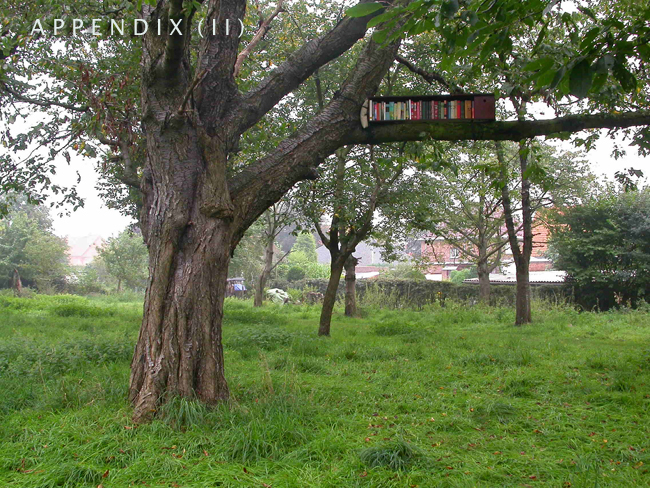
Appendix II, 2005
Home Version Tree Library / Open Monumentendag Zwijndrecht 2005
Excerpts from:
The Figurative Library: Imagination and Contemporary Art in the Public Library
Bibliotheek- & Archiefgids, No. 4, August 2003
By Geert Vermeire
Unlike other cultural forms, art is seldom associated with libraries. While literature has become a common feature in various museums, museums themselves have shifted away from their traditional role as temples of art toward becoming dynamic public spaces. These spaces focus not only on collections but also on imagination in diverse and evolving ways. Museums have moved beyond mere conservation; they constantly question themselves and actively engage in dialogue with their visitors. Writers and literature are frequently invited to collaborate in this process.
This article explores whether libraries are undergoing a similar transformation and investigates the role contemporary art might play within library spaces.
Letter to a Tree, 1996–1997
An Art Correspondence with a Chosen Tree
Buiten Gewoon, CC Heusden-Zolder, Belgium
Stefaan Van Biesen’s Brieven aan een Boom (Letters to a Tree, 1996–1997) explores fundamental questions about communication and language. The experience of nature, Van Biesen suggests, is ultimately inexpressible in words. His 38 letters form an intimate and vulnerable library—carefully enclosed in a case, like a shrine—where only the image remains. What, then, constitutes the existence of language?
In these works, the audience is stripped of the certainty that text usually provides. They are invited to reflect: Who am I without language? What does a world without words mean to me? Both Van Biesen and De Cordier create what might be called libraries of the imagination, placing delicate words in a shrine-like space. Words become like butterflies—strong and free in flight, yet fragile when at rest.
Books, as endangered objects, are ubiquitous in contemporary art. Embedded within this is the concept of the library as a sacred space—a shrine for preserving the fragile beauty of language and thought.
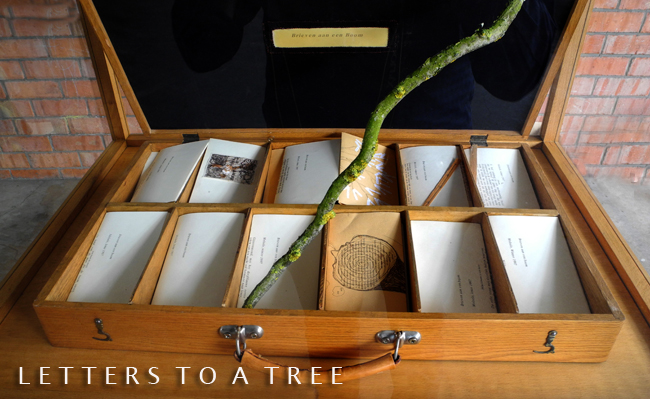
Art and Language
Throughout history, art and language have been deeply intertwined. The tendency to oppose word and image is largely a Western reflex—but in truth, word and image are inseparable. Poets, philosophers, and painters have always spoken a common language.
From the mid-20th century onward, Belgium has played a unique role in this ongoing dialogue between art and language. Few countries have given the word such prominence within image, object, and conceptual art. The works of René Magritte, Cobra artists, Christian Dotremont, Marcel Broodthaers, Jef Geys, Denmark, Fred Eerdekens, Patrick Corillon, Gaston De Mey, and many others exist through the power of the word. Jan Fabre’s well-known ‘blue bic’ artworks are another variation on this theme.
Contemporary Belgian artists like Wim Delvoye, Thierry De Cordier, and Stefaan Van Biesen continue to integrate word and image, driven by intensely personal worldviews. In Van Biesen’s Brieven aan een Boom (Letters to a Tree) and Brieven uit Schoorisse (Letters from Schoorisse), images seem to evaporate—only words remain. Their work invites us into a space of systematic, relentless doubt.
Thierry De Cordier isolates himself in his kitchen garden, and through his writing—a kind of withdrawal—the artist attempts to erase his presence. In Brieven uit Schoorisse (1988–1998), only landscapes, silence, and absence endure. Writing becomes an act of revocation.

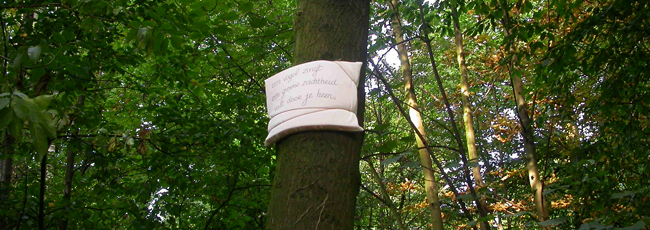
[The Nervated Skin] CC Ter Vesten Beveren Belgium 2006. A project with poet Geert Vermeire.
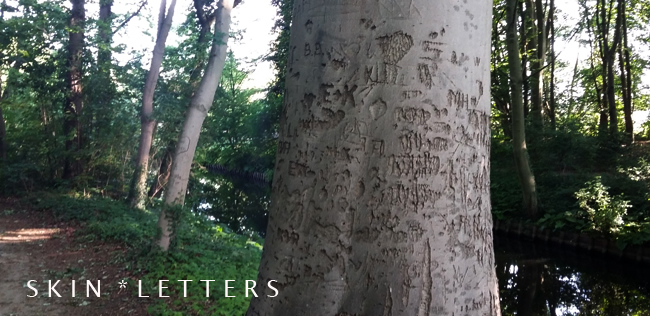
[Skin. Letters on my surface] Cortewalle park Beveren Belgium 1999.
Letters to a tree
A correspondence with a tree during autumn 1996 - spring 1997 for the art project 'Buiten Gewoon' CC Heusden-Zolder Belgium. Curated by Cathy Pelgrims.
[Download pdf English version Letters to a Tree] > >
[Download pdf Nederlandse versie van Brieven aan een boom] > >

Letters to a tree 1997
In Situ Installation & Performance
During the Buiten Gewoon art exhibition at CC Heusden-Zolder, Belgium, Stefaan Van Biesen’s Letters to a Tree took form as a live installation and performance. Throughout the day, the 38 letters were read aloud to the chosen tree in the park, while every two hours, the artist’s shadow was carefully traced and dug out in the ground—transforming the body into a living sundial.
This poetic gesture linked time, presence, and nature, deepening the dialogue between human and tree, language and silence.
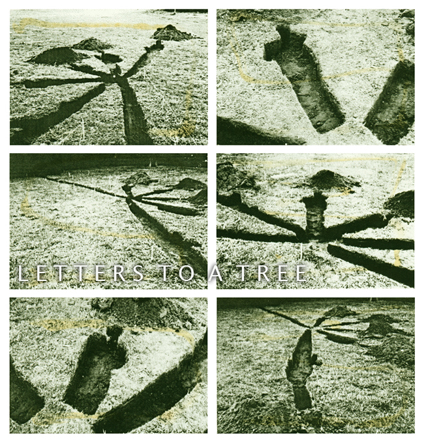
Photographs of the different stadiums of the shadows being dug out.

Wilhelmshöhe Kassel Germany 2007. Performance with Annemie Mestdagh & Ingrid Pee.
Letters to an orchard


'Monologue of a plein-airist' Stef Van Bellingen 1997.
In an epistolary novel, the letters are addressed to a fictitious person, who acts as a sounding board for the writer. In this case, the artist has chosen a tree in a park in Heusden-Zolder as the addressee. This tree has become the imaginary mirror of his thoughts. Yet it remains difficult to breach the confidentiality of the mail because the outpourings from the monologue are authentical. For the artist, the tree becomes a canal so that his own thoughts can surface and take shape in words and images. He reaches a sort of inner prospecting, a kind of esthetical prayer wherein he tries to define his place in the reality that surrounds him. During the childhood of the “tree-ful of letters”, more than one hundred growth rings ago, artists really started to observe nature. They didn‟t want to work according to the existing templates, and they started examining the sensation of light in 'plein air'. The subjectivity that comes with looking at nature in progress led to a revolution in Art. The accidental and whimsical play of light made art acquire a sketchy character in the end. Because the emphasis lay on the impression of the environment, the own instinctive looking and the personal viewpoint were accentuated. This is the way in which Stefaan van Biesen looks at the “human aviary” in which we live. To use the words of the artist, he “tries to stand up crippled as wood can be”, but with a certain amount of breathing space, somewhat away from the woods. “Just disagree with me for once”, he asks the tree, but the latter chooses for a deaf camouflage, so that the question is echoed back. In the dying reverberation, you only seem to hear “il faut faire sa propre vie”.

The same place 6 months later

The same place in 2020
![]()
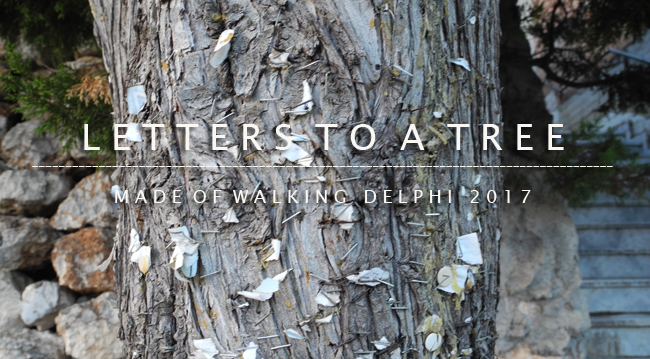
[Made of Walking] Delphi Summershool Animart Greece.
![]()
